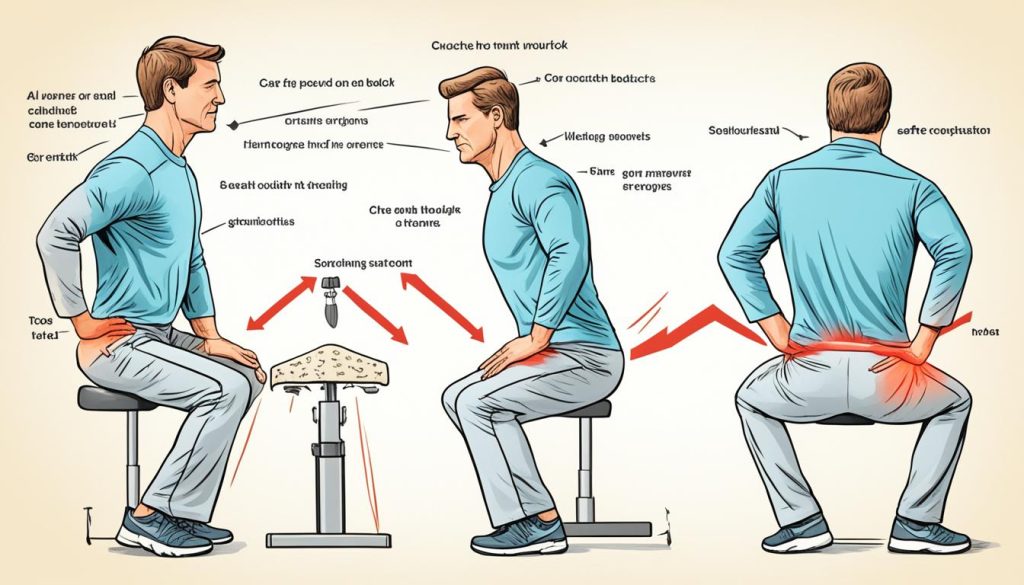Cracking your back is a common technique used to relieve pain and discomfort in the spine. Many people wonder, is it safe to crack your back? The answer is yes, as long as it is done correctly and with caution. In this article, we will explore safe back cracking techniques that you can try at home for temporary relief.
Before we delve into the techniques, it’s important to understand what happens when you crack your back. Cracking your back involves releasing trapped gas in the joints of the spine, which can provide a satisfying popping sensation. It also stretches the ligaments and tendons around the joints, allowing for increased flexibility.
While cracking your back is generally safe, it’s important to note that as you get older, it may become more difficult to crack your back. Additionally, if cracking your back worsens your lower back pain or if you have any concerns, it is recommended to seek medical help.
Now, let’s explore the benefits of cracking your lower back and safe techniques for cracking your back in different areas of the spine.
The Benefits of Cracking Your Lower Back
Cracking your lower back can provide several benefits. It relieves pressure on the joints, stretches the surrounding ligaments and tendons, and releases trapped gas in the joints. These benefits can help alleviate back pain, reduce stiffness, and improve flexibility. Cracking your lower back can be a self-adjustment technique that can provide temporary relief from discomfort.
When you crack your lower back, it creates a popping sound that occurs when the joint surfaces are separated. This release of trapped gas in the joints can provide immediate relief from back pain and stiffness. It can also help to improve the range of motion in your lower back, making it easier to perform daily activities without discomfort.
Back Pain Relief
One of the key benefits of cracking your lower back is the relief it provides from back pain. Many individuals experience lower back pain due to poor posture, muscle strain, or sedentary lifestyles. Cracking your lower back can help to relieve this pain by stretching the ligaments and tendons surrounding the joints, reducing muscle tension, and improving blood flow to the area.
The release of trapped gas in the joints also contributes to pain relief. When gas is trapped in the joints, it can cause inflammation and discomfort. Cracking your lower back helps to release this gas, alleviating pain and promoting a sense of relief.
Back Stiffness Remedies
Back stiffness is a common condition experienced by many individuals. It can be caused by various factors such as muscle tension, inflammation, or joint dysfunction. Cracking your lower back can be an effective remedy for back stiffness.
When you crack your lower back, it stretches the ligaments and tendons surrounding the joints, promoting flexibility and reducing stiffness. The release of trapped gas in the joints also helps to relieve stiffness by reducing inflammation and promoting better joint movement.
Self Back Adjustments
Cracking your lower back is a self-adjustment technique that can be easily performed at home. It allows you to take control of your back health and provide temporary relief from discomfort without the need for professional intervention.
Performing self back adjustments can be empowering and convenient. It can be done at any time and in the comfort of your own home. However, it is important to note that self-adjustments should be done cautiously and with proper technique to avoid injuring yourself.
Here are a few self back adjustment techniques for cracking your lower back:
| Technique | Description |
|---|---|
| Seated Back Press | Place your hands on your lower back while seated on a chair and press your hands into your back, bending backward slightly to crack the joints. |
| Chair Twist | While sitting on a chair, twist your torso to one side and grab the back of the chair with both hands. Gently twist and lean to each side to crack the joints in your lower back. |
| Bridge Stretch | Lie flat on your back with your knees bent and feet flat on the floor. Lift your hips off the ground, creating a bridge shape with your body. Slowly lower your back down to the ground to crack the joints in your lower back. |
Remember to perform these techniques slowly, gently, and within your comfort range. If you experience any pain or discomfort while cracking your lower back, it is important to stop and consult with a healthcare professional.

How To Crack Your Back?
Safe Ways to Crack Your Lower Back
When it comes to cracking your lower back, there are several safe and effective methods you can try on your own. These techniques can help relieve tension, reduce discomfort, and improve overall flexibility. However, it’s important to approach these methods with caution and prioritize your safety. Here are some safe ways to crack your lower back:
- Seated techniques: One method is to press your hands into the back while seated on a chair. Apply gentle pressure to the areas where you feel the need to crack, and adjust the intensity based on your comfort level. You can also try twisting in the chair and grabbing the back of the seat for added support.
- Bridge stretch: Lie on your back with your knees bent and feet flat on the floor. Slowly lift your hips off the ground until your body forms a bridge shape. Hold this position for a few seconds, then lower your hips back down. Repeat as needed.
- Kneeling back extensions: Start by kneeling on all fours, with your hands directly under your shoulders and your knees under your hips. Gently arch your back upward, extending it as much as you comfortably can. Hold this stretch for a few seconds, then relax your back. Repeat as desired.
- Prone extensions: Lie on your stomach with your elbows bent or your arms straight, resting on your forearms. Slowly lift your upper body off the ground, using your arms for support. Keep your lower body relaxed and let your back stretch naturally. Hold for a few seconds, then lower yourself back down.
- Spinal twist exercise: Sit on the floor with your legs extended in front of you. Cross one leg over the other, placing your foot flat on the ground next to your opposite knee. Twist your torso in the direction of the crossed leg, using your opposite hand to support you. Hold for a few seconds, then switch sides.
- Knee-to-chest stretch: Lie on your back with your legs extended. Slowly bring one knee up towards your chest, using your hands to hug your leg closer. Hold for a few seconds, then release and repeat with the other leg. This stretch can help relieve tension in the lower back.
It’s crucial to perform these cracking techniques slowly and gently to avoid any potential injury. Never force any movement or push beyond your body’s limits. If you experience any pain or discomfort during the process, stop immediately and consult with a healthcare professional.

Comparing Safe Ways to Crack Your Lower Back
| Technique | Description |
|---|---|
| Seated techniques | Pressing hands into the back while seated or twisting in a chair and grabbing the back of the seat |
| Bridge stretch | Lying on your back and lifting your hips into a bridge position |
| Kneeling back extensions | Kneeling on all fours and gently arching your back upward |
| Prone extensions | Lying on your stomach and lifting your upper body off the ground |
| Spinal twist exercise | Sitting on the floor and twisting your torso in the direction of a crossed leg |
| Knee-to-chest stretch | Lying on your back and bringing one knee up towards your chest |
Cracking Your Middle Back with Simple Stretches
To crack your middle back and provide relief and flexibility, you can incorporate simple stretches that involve extending and twisting the spine. These stretches can be done by yourself and are effective techniques for cracking your back. Remember to perform these stretches with caution and avoid forcing any movements.
Examples of Middle Back Stretches
Here are some examples of stretches that can help you crack your middle back:
| Stretch | Description |
|---|---|
| Back-of-Chair Stretch | This stretch involves standing in front of a chair, placing your hands on the backrest, and slowly bending forward to stretch your middle back. |
| Chair Twist | Sit on a chair with your feet flat on the floor. Twist your upper body to the right or left while holding onto the back of the chair for support. |
| Back Extension | Lie on your stomach with your hands placed on the floor near your shoulders. Push your upper body up, extending your spine and stretching your middle back. |
| Standing Lumbar Extension | Stand with your feet shoulder-width apart and place your hands on your lower back. Lean back gently to extend your spine and target your middle back. |
Remember to perform these stretches with proper form and control. Listen to your body and stop if you experience any pain or discomfort. Regularly incorporating these stretches into your routine can help maintain a flexible and pain-free middle back.
Cracking Your Upper Back with Gentle Movements
To crack your upper back, you can try gentle movements that involve twisting, extending, and rotating the spine. These movements can provide relief and mobility to the upper back area. Below are some examples of these gentle movements:
- Upward Stretch: Stand with your feet shoulder-width apart and extend your arms above your head, interlocking your fingers. Gently lean backward, arching your back and stretching your upper spine. Hold the stretch for a few seconds and then return to the starting position.
- Standing Spinal Rotation: Stand with your feet shoulder-width apart and place your hands on your hips. Slowly rotate your upper body to the right, keeping your lower body stable. Hold the stretch for a few seconds and then rotate to the left. Repeat the rotation on each side a few times.
- Seated Twist: Sit on a chair with your feet flat on the ground. Place your left hand on your right knee and gently twist your upper body to the right, using your hand as leverage. Hold the twist for a few seconds and then repeat on the opposite side.
- Supine Foam Roller Stretch: Lie on your back and place a foam roller horizontally under your upper back. Bend your knees and place your feet flat on the ground. Allow your upper back to relax and sink into the foam roller, feeling a gentle stretch. Hold the stretch for a few seconds and then slowly roll off the foam roller to the starting position.
Remember, when cracking your upper back, it’s important to listen to your body and not push beyond your limits. If any movement causes pain or discomfort, stop immediately. It’s always a good idea to consult with a healthcare professional if you have any concerns or if you want to learn how to crack your back like a chiropractor.

| Benefits of Cracking Your Upper Back | Gentle Movements to Crack Your Upper Back |
|---|---|
| – Relieves tension and stiffness | – Upward Stretch |
| – Improves flexibility | – Standing Spinal Rotation |
| – Releases trapped gas in the joints | – Seated Twist |
| – Provides temporary relief from discomfort | – Supine Foam Roller Stretch |
Seeking Professional Help for Back Adjustments
While it is generally safe to crack your own back, there are times when seeking professional help for back adjustments is recommended. Chiropractors and osteopaths are trained in performing spinal manipulations and adjustments that can effectively treat back pain and discomfort. These professionals have the expertise to assess your condition and provide targeted treatments beyond what can be achieved at home.
When it comes to spinal manipulation at home, it’s important to recognize the limitations. While self-adjustments can provide temporary relief, they may not address the underlying cause of your back issues. Professional back adjustments offer a comprehensive approach and can help alleviate pain, improve mobility, and promote overall spinal health.
Why Seek Professional Help?
There are several reasons why it’s advisable to consult with a professional for your back adjustments:
- Experience and Expertise: Chiropractors and osteopaths possess extensive training and knowledge in spinal health and adjustments. They have a deep understanding of the musculoskeletal system and can tailor treatments to suit your specific needs.
- Advanced Techniques: Professionals have access to a wide range of advanced techniques that can provide targeted relief and address specific back issues. These techniques may include spinal mobilization, traction, massage therapy, and other specialized treatments.
- Comprehensive Assessment: Professionals can perform a thorough evaluation of your back condition, taking into account your medical history, lifestyle, and any underlying conditions. This ensures a personalized and holistic approach to your treatment.
- Safe Environment: Seeking professional help ensures that your back adjustments are performed in a controlled and safe environment. Professionals adhere to strict standards and protocols to minimize the risk of injury or complications.
When to Consider Professional Back Adjustments
If self-adjustments at home are not providing sufficient relief or if you have any underlying conditions, it’s best to consult with a professional. They can evaluate your back condition and determine the most appropriate course of action. Some instances when professional help may be necessary include:
- Severe or Chronic Back Pain: If your back pain is persistent, severe, or worsening, professional intervention can help identify the underlying cause and provide effective treatment.
- Specific Conditions: If you have conditions such as herniated discs, spinal stenosis, or scoliosis, a professional can develop a customized treatment plan that takes these factors into account.
- Risk Factors: Certain factors, such as a high risk of stroke, pregnancy in the third trimester, or moderate to severe osteoporosis, require specialized care and caution when it comes to back adjustments.
- Lack of Relief: If self-adjustments and other home remedies are not providing the desired relief or if your symptoms are worsening, it’s essential to seek professional help for a comprehensive evaluation and targeted treatment.
When Not to Crack Your Back
While cracking your back can provide relief, it is important to be aware of situations in which it should be avoided. Cracking your back may not be safe or suitable if you experience any of the following:
- Swelling or redness along the back
- Acute or severe pain
- High risk of stroke
- Third trimester of pregnancy
- Numbness, tingling, or weakness in the legs
- Moderate to severe osteoporosis
It is crucial to listen to your body and pay attention to any concerns or worsening of symptoms when cracking your back. If you have any of the aforementioned conditions or are unsure about the safety of cracking your back, seeking medical help is advised.

| Condition | Precautions |
|---|---|
| Swelling or redness along the back | Avoid any movements that may exacerbate the inflammation. Consult a medical professional for appropriate treatment. |
| Acute or severe pain | Cracking your back may worsen the pain. Seek medical attention for a proper diagnosis and treatment plan. |
| High risk of stroke | Refrain from any activities that may increase the risk of stroke, including forceful back cracking. Consult a healthcare provider for guidance. |
| Third trimester of pregnancy | Pregnant women should avoid any actions that put undue pressure on the abdomen or back. Consult an obstetrician for advice on managing back pain during pregnancy. |
| Numbness, tingling, or weakness in the legs | These symptoms may indicate nerve compression or other underlying conditions. It is important to consult a healthcare professional for a proper evaluation. |
| Moderate to severe osteoporosis | Individuals with osteoporosis may have fragile bones that are prone to fractures. Cracking the back can increase the risk of injury. Consult with a specialist to explore alternative pain management options. |
Conclusion
Cracking your back can be a safe and effective method for relieving back pain and improving flexibility. By following proper techniques and listening to your body, you can safely perform self-adjustments at home. However, it is crucial to consult with a professional if you have any underlying conditions or if self-adjustments do not provide sufficient relief.
Remember that safety should always be a priority when cracking your back. Avoid applying excessive force or overdoing it, as this may lead to injury. It is also important to be aware of any redness, swelling, acute pain, or other concerning symptoms, as these may indicate a need for professional medical attention.
In conclusion, cracking your back can be a beneficial practice, but it is essential to exercise caution and seek guidance when needed. By taking the necessary precautions and being mindful of your body’s signals, you can find relieving back pain and improving your overall well-being.
FAQs
Is it safe to crack your back?
Cracking your back is generally safe and can provide relief from pain and discomfort. However, it is recommended to perform these self-adjustments slowly and gently to avoid injury.
What are some back cracking techniques?
Some common techniques to crack your back include seated techniques, such as pressing your hands into your back while sitting on a chair, and twisting in the chair while grabbing the back of the seat.
Should I seek professional help for back adjustments?
While it is generally safe to crack your own back, it is recommended to consult with a professional chiropractor or osteopath for back adjustments, especially if you have underlying conditions or if self-adjustments are not providing sufficient relief.
When should I avoid cracking my back?
It is best to avoid cracking your back if you have swelling or redness along the back, acute or severe pain, a high risk of stroke, are in the third trimester of pregnancy, have numbness, tingling, or weakness in the legs, or have moderate to severe osteoporosis. Always listen to your body and seek medical help if you have any concerns or if cracking your back worsens your symptoms.

